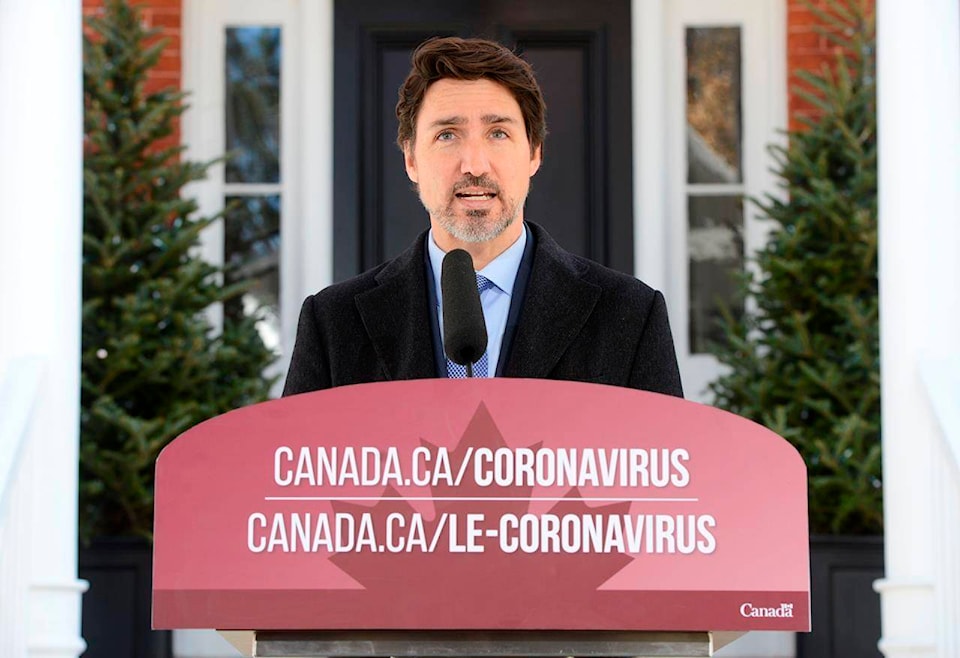OTTAWA — The longer it takes for all Canadians to follow the rules and stay home to curb the spread of COVID-19, the longer it will be before life can return to normal, Prime Minister Justin Trudeau said Wednesday.
Canadians are nearing the end of their third week in physical isolation with the prospect of at least another month, and likely much longer than that, before restrictions on businesses and public gatherings might start to loosen.
Government financial aid packages right now are set to last at least until the end of June, including the new 75 per cent wage subsidy which Finance Minister Bill Morneau estimated Wednesday will cost $71 billion.
Trudeau is asking for Parliament to be recalled to pass the legislation required to implement the new subsidy, which will apply to large and small businesses, including charities and non-profits, which have seen revenues drop at least 30 per cent because of the pandemic.
Morneau said he would be open to extending the program past the end of June if necessary but nobody in the federal government was willing to say when they think the public health threat from COVID-19 will allow a return to normal activities.
Health Minister Patty Hajdu and Dr. Theresa Tam, the chief public health officer, both said there is a lot of work underway trying to determine various scenarios but the planning isn’t easy because it is so dependent on the behaviour of individual Canadians. Hajdu was terse when she said every Canadian is responsible for how long “we are stuck” inside.
“If we all stopped moving for two weeks and nobody talked to anybody for two weeks and we all just stayed put, in fact we would see this virus would die,” she said.
Trudeau said Canadians have a “duty” to listen to the advice, which includes staying home as much as possible, limiting trips to get essentials to one store, once a week, and making sure if you are allowed to go out for a walk, that you stay at least two metres away from people you don’t live with.
Anyone arriving in Canada from abroad is required by law to quarantine themselves for 14 days, and anyone with symptoms or who has been exposed to someone with COVID-19 must also stay home and not go outside for any reason, said Trudeau.
“Everything depends on how Canadians behave,” he said.
Tam said this is a critical week in Canada’s understanding of the effect social-distancing measures are having on the spread of the virus. Most provinces began slowing things down in mid-March, and there can be about a two-week lag in data on positive tests because it takes several days after exposure for symptoms to appear and several days after that for a test to yield results.
Canada is reporting more than 9,000 positive tests and more than 100 deaths now, but Tam said what matters more than the overall numbers is the epidemic curve that shows when the people who test positive actually got sick. The current curve suggests the number of people first showing symptoms began to peak in the third week of March, but there is still a lot of data missing for positive cases detected in the last week or so.
Tam said she won’t know when Canada has hit its peak for COVID-19 until that peak is behind us.
Ontario reported Wednesday its biggest single daily jump in positive cases thus far, with 426 additional positive tests, but information on those people’s likely method of exposure — through travel or community spread, for example — as well as when symptoms began is not clear yet.
The jump is particularly concerning for Toronto public health chief Dr. Eileen de Villa, who asked Wednesday for stricter measures to force people who are sick, and anyone who has come into contact with them, to stay home for 14 days.
She asked other Torontonians to limit trips to the store and stay away from other people as much as possible. She wants the measures in place for at least 12 weeks, though she too said how long they are needed will depend on how well people comply.
Tam said most of the big outbreaks in Canada are concentrated in long-term care facilities, and while younger people can and are getting very sick from this virus, older Canadians are at higher risk for serious complications. Current data shows people over the age of 60 account for 60 per cent of hospitalizations and 93 per cent of deaths, said Tam.
Trudeau also said Wednesday that shipments of protective equipment, including face masks, for front-line health workers are expected to arrive in Canada in the next couple of days.
Canada has a national emergency stockpile but Hajdu said Wednesday it is clear the number of masks and other protective equipment in that stockpile was not enough. She said governments around the world have been underfunding public health for decades and it has now come back to haunt them all.
“We are pulling out all of the stops” to get masks and equipment into the hands of people that need them, she said.
Canada is still not recommending members of the general public use face coverings, but Tam acknowledged Wednesday while the effectiveness of using homemade fabric masks is unproven, there “may not be any harm” in doing so.
Although the government’s direct financial aid package to respond to COVID-19 is now well above $100 billion, Freeland and Morneau both said more will come if it is needed.
Some organizations and the NDP are asking for rent relief to help people who can’t pay their rent right now. Freeland said in many places it is currently illegal to evict someone, but added even in places where that isn’t the case, “it would be a heartless act indeed to evict someone” right now.
This report by The Canadian Press was first published April 1, 2020.
Mia Rabson, The Canadian Press
